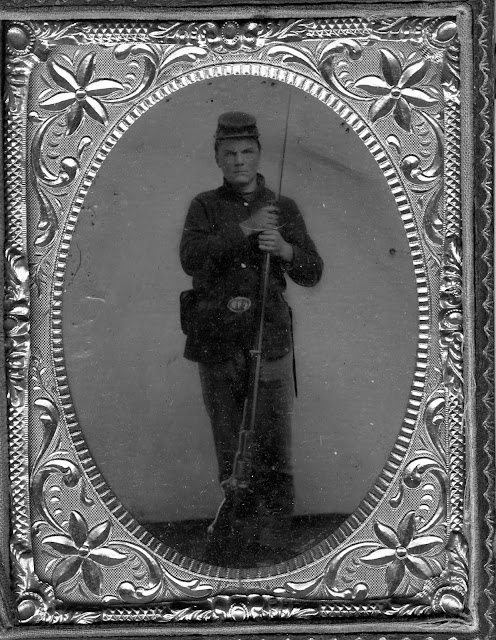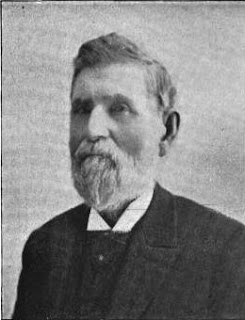Copperhead County- Holmes County Ohio Newspapers in the Civil War
Holmes County, Ohio, nestled in northeastern part of the state which during the Civil War proved a bastion of Republican power, was an abberation- a blue county in a sea of red. The county then was home to a large population of Amish farmers, who at the time were largely Democrats. Holmes County, then as now, was an agrarian county with a population of about 20,000 people. (It is interesting to note that Holmes County had about the same population from 1850 to 1970, and is about 40,000 population today.) Millersburg was the county seat and at the outset of the war boasted two newspapers, the Republican Holmes County Republican and the Democratic Holmes County Farmer under James A. Estill. Chronicling America has an entire run of the Farmer covering the war years of 1861-65 and beyond, but coverage of the Republican ends with the April 17, 1862 issue.
As could be expected, the two newspapers represented vastly opposed strains of political thought- the Republican was a staunch friend of the Lincoln administration while the Farmer espoused the Copperhead sentiments best enunciated by Clement L. Vallandigham. Throughout the Civil War, Judge Estill maintained a firefight with the varied editors of the Republican- James Caskey who sold the paper in April 1862, and G.T. Griffith of Cincinnati who purchased it from Caskey. Estill had a healthy respect for Caskey and complimented him on running an honorable (if wrong headed) newspaper, but as time progressed, he developed a loathing for Griffith who (Estill claimed) used the pages of the Republican for "disparagement of the town and county, to the destruction of our business interests, to slander and falsehood, to the incitement of contention and strife among neighbors, and to the instigation of mobs and violence upon our peaceful citizens." Issues of the Republican are only available online through Caskey's sale of the paper in April 1862, so one is left to wonder what Griffith reported that stoked Estill's ire to such a fever pitch. But it is reasonable to assume to Griffith reported unsavory details of the Holmes County Rebellion and other local unpleasantries- it would be wonderful to read, but we are left to speculate. (Patrick Drouhard's It Don't Look Right for the Times: A Factual History of the Holmes County Rebellion is a good read for those intrigued by the mere mention of rebellion in Ohio during the Civil War.)
Holmes County, in many respects, was a bastion of Copperheadism. Republican candidates lost by about a 2 to 1 margin during the 1862, 1863, and 1864 elections, which makes it no surprise that the Holmes County Republican struggled financially throughout the war and ceased publication in mid April 1865. Judge Estill had the pleasure of reporting the departure of the despised Griffith in the same issue in which he reported the assassination of a perhaps equally despised President Lincoln, whom Estill lampooned during the 1864 election as the "Widow Maker." In all fairness, Estill lamented that Lincoln had been assassinated, yet the violence of his anti-administration rhetoric throughout Lincoln's term leaves this researcher questioning the sincerity of his editorial tears shed in April 1865.
Aside from politics and of primary interest to this blog is the endless pursuit for soldiers' correspondence, and the two papers did not disappoint, especially in the early stages of the war. Letters from soldiers in the 16th Ohio Infantry (both three months' and three years' service) abound, and a one correspondent worthy of note is First Lieutenant Manuel B. DeSilva of Co. E who was dismissed in the summer of 1863 for his disloyal letters published in the Farmer- they certainly make interesting reading. Company F of the 65th Ohio had a number of correspondents who wrote to the Farmer, as did Co. C of the 67th Ohio whose best correspondent (Captain Marcus M. Spiegel) went on to become colonel of the 120th Ohio before being killed in action at Snaggy Point, Louisiana in May 1864. Private Charles Hay of Co. H, 23rd Ohio wrote a superb series of letters describing the movements of the Kanawha Division during the summer campaign of 1862 which culminated at South Mountain and Antietam. A few letters from men in the 32nd Ohio, 51st Ohio, 102nd Ohio, and 120th Ohio make their way into the pages, as well as a few out of state accounts from Illinois and Iowa regiments. My recent blog post "A Buckeye at Pea Ridge" (http://dan-masters-civil-war.blogspot.com/2018/06/a-buckeye-at-pea-ridge.html) features one of these letters; and one can find accounts of the battles of Philippi, Rich Mountain, Cheat Mountain, Fort Donelson, First Kernstown, Cumberland Gap, South Mountain, Antietam, Chickasaw Bayou (several from members of the 16th OVI which lost half its numbers there), Stones River, Prairie Grove, and Vicksburg. As is typical of Democratic papers, the volume of correspondence really diminishes after the 1863 gubernatorial election.
Overall, I was impressed with the quality of many of the accounts and would rate the Farmer as one of the better Democratic papers (at least as far as volume of variety of soldiers' correspondence) of the state. The Republican didn't have quite the volume of letters, and available issues run out just about the time when things started to get very interesting for the Holmes County units. The Farmer ran about 140 letters, most of them prior to May 1863, while the Republican published 35 between May 1861 and April 1862.
That said, I have constructed an index for both newspapers and posted it online for your viewing pleasure at: https://columbianarsenal.com/newspaper-indexes
Chronicling America link to Holmes County Republican: https://chroniclingamerica.loc.gov/lccn/sn84028821/
Chronicling American link to Holmes County Farmer: https://chroniclingamerica.loc.gov/lccn/sn84028822/
 |
| Map of Ohio with Holmes County circled in red. |
As could be expected, the two newspapers represented vastly opposed strains of political thought- the Republican was a staunch friend of the Lincoln administration while the Farmer espoused the Copperhead sentiments best enunciated by Clement L. Vallandigham. Throughout the Civil War, Judge Estill maintained a firefight with the varied editors of the Republican- James Caskey who sold the paper in April 1862, and G.T. Griffith of Cincinnati who purchased it from Caskey. Estill had a healthy respect for Caskey and complimented him on running an honorable (if wrong headed) newspaper, but as time progressed, he developed a loathing for Griffith who (Estill claimed) used the pages of the Republican for "disparagement of the town and county, to the destruction of our business interests, to slander and falsehood, to the incitement of contention and strife among neighbors, and to the instigation of mobs and violence upon our peaceful citizens." Issues of the Republican are only available online through Caskey's sale of the paper in April 1862, so one is left to wonder what Griffith reported that stoked Estill's ire to such a fever pitch. But it is reasonable to assume to Griffith reported unsavory details of the Holmes County Rebellion and other local unpleasantries- it would be wonderful to read, but we are left to speculate. (Patrick Drouhard's It Don't Look Right for the Times: A Factual History of the Holmes County Rebellion is a good read for those intrigued by the mere mention of rebellion in Ohio during the Civil War.)
Holmes County, in many respects, was a bastion of Copperheadism. Republican candidates lost by about a 2 to 1 margin during the 1862, 1863, and 1864 elections, which makes it no surprise that the Holmes County Republican struggled financially throughout the war and ceased publication in mid April 1865. Judge Estill had the pleasure of reporting the departure of the despised Griffith in the same issue in which he reported the assassination of a perhaps equally despised President Lincoln, whom Estill lampooned during the 1864 election as the "Widow Maker." In all fairness, Estill lamented that Lincoln had been assassinated, yet the violence of his anti-administration rhetoric throughout Lincoln's term leaves this researcher questioning the sincerity of his editorial tears shed in April 1865.
Aside from politics and of primary interest to this blog is the endless pursuit for soldiers' correspondence, and the two papers did not disappoint, especially in the early stages of the war. Letters from soldiers in the 16th Ohio Infantry (both three months' and three years' service) abound, and a one correspondent worthy of note is First Lieutenant Manuel B. DeSilva of Co. E who was dismissed in the summer of 1863 for his disloyal letters published in the Farmer- they certainly make interesting reading. Company F of the 65th Ohio had a number of correspondents who wrote to the Farmer, as did Co. C of the 67th Ohio whose best correspondent (Captain Marcus M. Spiegel) went on to become colonel of the 120th Ohio before being killed in action at Snaggy Point, Louisiana in May 1864. Private Charles Hay of Co. H, 23rd Ohio wrote a superb series of letters describing the movements of the Kanawha Division during the summer campaign of 1862 which culminated at South Mountain and Antietam. A few letters from men in the 32nd Ohio, 51st Ohio, 102nd Ohio, and 120th Ohio make their way into the pages, as well as a few out of state accounts from Illinois and Iowa regiments. My recent blog post "A Buckeye at Pea Ridge" (http://dan-masters-civil-war.blogspot.com/2018/06/a-buckeye-at-pea-ridge.html) features one of these letters; and one can find accounts of the battles of Philippi, Rich Mountain, Cheat Mountain, Fort Donelson, First Kernstown, Cumberland Gap, South Mountain, Antietam, Chickasaw Bayou (several from members of the 16th OVI which lost half its numbers there), Stones River, Prairie Grove, and Vicksburg. As is typical of Democratic papers, the volume of correspondence really diminishes after the 1863 gubernatorial election.
Overall, I was impressed with the quality of many of the accounts and would rate the Farmer as one of the better Democratic papers (at least as far as volume of variety of soldiers' correspondence) of the state. The Republican didn't have quite the volume of letters, and available issues run out just about the time when things started to get very interesting for the Holmes County units. The Farmer ran about 140 letters, most of them prior to May 1863, while the Republican published 35 between May 1861 and April 1862.
That said, I have constructed an index for both newspapers and posted it online for your viewing pleasure at: https://columbianarsenal.com/newspaper-indexes
Chronicling America link to Holmes County Republican: https://chroniclingamerica.loc.gov/lccn/sn84028821/
Chronicling American link to Holmes County Farmer: https://chroniclingamerica.loc.gov/lccn/sn84028822/









Comments
Post a Comment